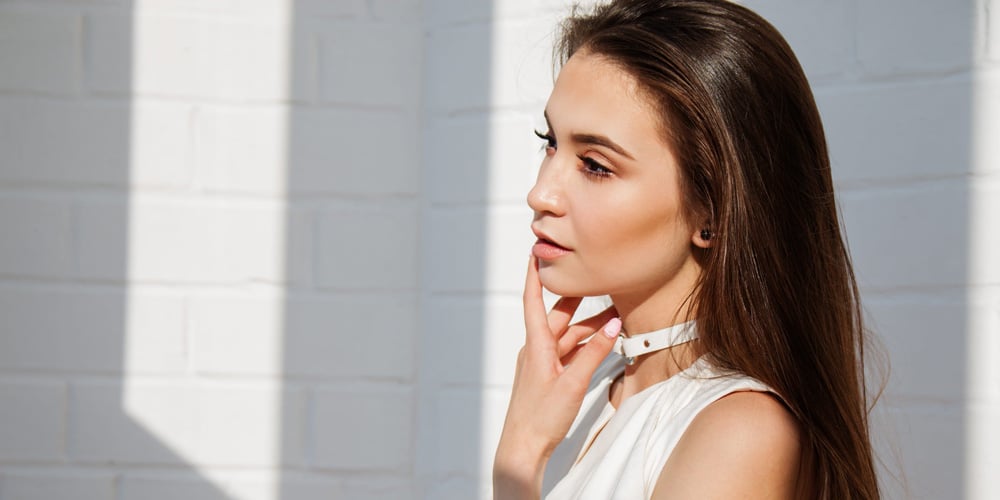Keratin is the raw material of our hair, accounting for 97% of its final composition. Is it a living or a dead organ? Is it fragile or infinitely manipulable? Its complex structure is not easily tamed...
Hair formation and keratinisation
Keratin is produced by keratinocytes, the hair's constituent cells, which are themselves fed by blood from the papilla. Located in the matrix at the bottom of the hair follicle, these cells divide into daughter cells throughout the anagen phase of a hair's life cycle. The ballet of keratinocytes is ceaseless, remarkably orchestrated and merciless...
As soon as they are formed, the daughter cells split immediately, crowding out the previous ones, causing them to lose their nuclei, die and become rigid, pushing them upwards. They then die in turn to make way for the next cells. This reproduction of cells takes place in record time, the fastest in the body, between 24 and 72 hours. Keratin arises from this storage of dead cells, which harden (keratinisation) and move relentlessly up the hair follicle (red arrows) to form the hair surface as we see it.
From the outset, we can see that we are dealing with a dead material from the moment it was produced by the hair root. This death has its corollary: we can manipulate the keratin in our hair at will, without any painful reaction on our part and therefore without any kind of safeguard. Which is not to say, without damage to the different layers of keratin that make up the hair structure!
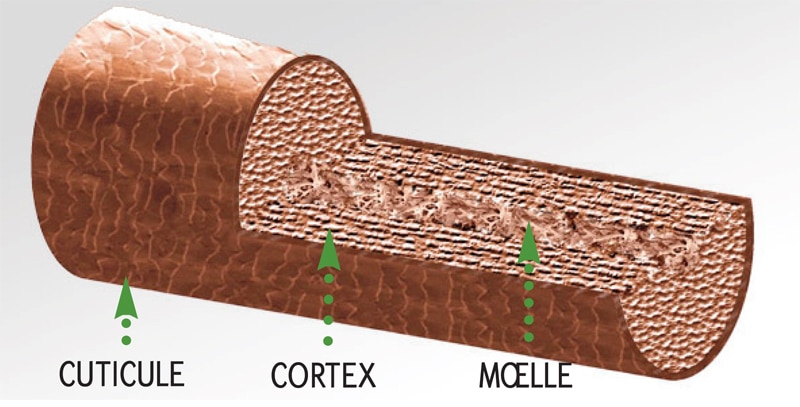
Hair structure
Viewed in cross-section, hair comprises three concentric layers of keratin. Outside, the cuticle consists of a thin protective envelope. In the middle, the cortex, The intermediate "bark" and strongest part of the hair represents 90% of its total weight. In the centre, the marrow.
The cuticle
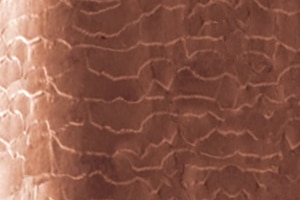
It consists of scales made of sheets of keratin thin and ultra-flat, stacked one on top of the other in several closely juxtaposed layers, like roof tiles. Vertically, these scales interlock with other scales, those of the inner sheath of the hair follicle, facing upwards. How they fit together allows the hair shaft to move upwards, like a cogwheel, and grow along the follicle. Horizontally, the scales of the cuticle are linked together by ceramides, precious oily substances, mainly made up of essential fatty acids. Located on and between the scales, ceramides have a triple function:
- Cement function. Ceramides form the material that seals the scales of the cuticle together, like cement holds together the bricks of a wall. Thus "masoned", the scales provide a smooth surface that enables the hair to protect itself against external aggression and reflect light (shine effect).
- Barrier function. Ceramides prevent the water inside the hair from escaping.
- Sponge function. Ceramides can also absorb a certain amount of water from the humidity in the air, to keep the hair shaft evenly hydrated.
The cortex
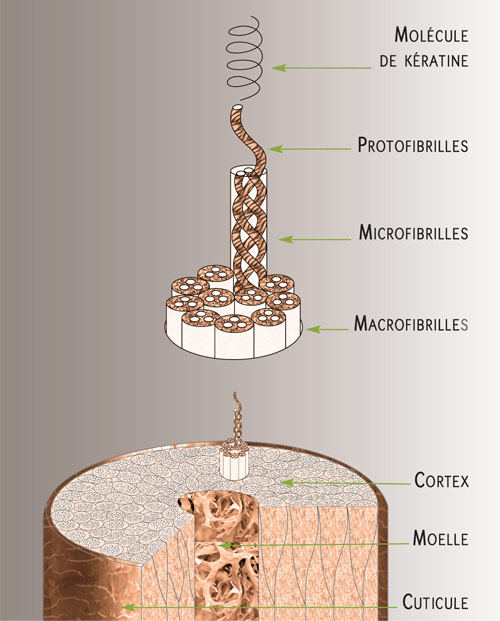
Vertically, we find multiple strands of protein, embedded in one another like Russian dolls, with: macrofibrils, which are themselves made up of several thousand microfibrils, which are in turn assembled into protofibrils (primitive fibrils). The chains, twisted like springs, follow the axis of the hair and give it its elasticity. They do not move in a vacuum...
Horizontally, these protein chains are sealed together by sulphur molecules: the disulphide bridges. These bridges give the chains their rigidity and coherence. The term "bridge" is not taken at random: it reflects the solidity of this second type of protein, which cannot be modified in any way other than by an external chemical intervention that will have to destroy them temporarily if the shape of the hair is to be changed.
In the formation of keratin, these particular acids are mainly represented by cystine. Carried by the blood to the hair root, cystine requires zinc and vitamin B6 to be synthesised.
Cystine + Zinc + Vitamin B6, you'll find these 3 elements in every dietary supplements to boost hair strength.
The marrow
The marrow resembles a large tube. Made up of cells without a nucleus, it plays no role in hair vitality (contrary to popular belief).
* Clinical tests conducted in 2013 and 2014 by molecular biologist S. Morot for the Centre Clauderer, showed that the growth rate of these hair-producing cells was more than doubled with Clauderer 6R Serum.
The 10 properties of keratin
Permeability
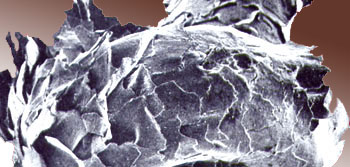
Keratin is sensitive to humidity, like a sponge, and can retain up to 40% of its weight in water. The hair then starts to swell and can gain 15, 20% in diameter. Ambient humidity therefore significantly modifies the physical structure of the hair. This hydrophilic power is widely used in cosmetics. to change hair colour.
Under the action of an alkaline liquid, the scales of the cuticle lift, like lids, to allow the colouring product to pass into the cortex and the skin. modify the hair's natural pigment. The same principle applies when curling or straightening hair: the scales must be straightened to allow the chemical product to penetrate the cortex. If these operations are carried out incorrectly or too frequently, the cuticle deteriorates, it loses the protection of its ceramides and its scales remain half-open, or even wide open (photo below).
Elasticity
Elasticity is keratin's most astonishing property. In the cortex, fibres twisted into helices allow hair to stretch like a spring, and then return easily to its initial length. These fibres are real shock absorbers and you can do the test yourself: take a hair, stretch it gently, it will lengthen by 25 to 30 %, without breaking. When you release it, it will return to its original shape. Now take a wet hair and repeat the experiment: it will stretch by 50 %. If your hair doesn't pass these tests if they break this means that they are not in good health.
Resistance
Its diameter does not exceed one tenth of a µm, but to break the keratin of a hair, the load required varies from 60 gr (African hair) to 100 gr (Asian hair). A head of hair with 100,000 hairs could therefore support from 600 to 1 000 kg. But this remains highly theoretical as the scalp would give way first!
Durability
Keratin is insensitive to decomposition and retains traces of all the substances that the blood or sweat communicated to the keranocytes during its manufacture. This makes it possible to detect anything that the owner of a hair has ingested through food or medication, the substances he has smoked, and its periods of stress.
The traceability of doping substances in athletes' hair means that they can be traced further back in time than blood or urine (provided the hair has not been shaved just before a test!).
The rot-proof nature of keratin is also used to make the dead talk. The best-known example is that of Napoleon: arsenic was found in his hair, leading historians to speculate that his English guards had poisoned him. Today, nuclear DNA, found in the root of a plucked hair, is widely used to put criminals on file or to research ancestry.
Colour
Produced in the hair matrix, melanocytes are the cells that synthesise the melanin pigment and transmit it to the keranocytes to colour the keratin. With age, their disappearance makes the white hair. Keratin contains two types of pigments: the granular pigments, brown to black, which govern the dark or "reddish" tones, and the diffuse pigments, yellow to light brown, for blond tones. It is the mixture of the two types that determines the natural colour of each hair and explains the infinity of the palette. Hasn't it been said, as with fingerprints, that there is no such thing as two completely identical hair colours? In France, first place goes to chestnut (more than 50 %). Over the last century, with the intermingling of populations, they have been steadily increasing. The last place goes to redheads, with a small 5%.
Plasticity
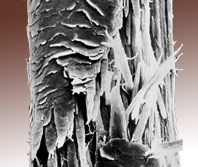
The plasticity of a material is its ability to retain a given shape. Keratin lends itself well to this kind of exercise. Under the effect of heat and water, a blow-dry temporarily changes the shape of the hair. The plasticity of hair also makes it possible to change its natural shape permanently. The operation is commonplace in cosmetics: all it takes is a chemical agent to break the disulphide bridges, the vulnerable points of keratin, its Achilles heel, as it were. The fibres then lose their structure and rigidity, becoming 'invertebrate'. Once the desired deformation has been achieved, the bridges are re-bonded by oxidation and the keratin regains its consistency.
Please note that certain operations, such as straightening are far from harmless. If the chemical products are too aggressive or if the pause times are not respected, the fibres are not restructured properly, the hair is damaged, the hair flakes and becomes easily brittle.
Electricity
Keratin is an insulating material that easily traps static electricity. The hair will be all the more electric they will lack sebum, their cuticle will be damaged and the air outside will be dry. There are various ways of alleviating this problem.
Gloss
This is the hair's ability to reflect light. On a healthy keratin, the scales of the cuticle, well welded to each other by their ceramides, have a perfectly smooth, flat façade which creates a mirror effect. On the other hand, if the scales are open and irregular, the roughness of the surface makes dull hair.
Sensitivity
The vitality of keratin is sensitive to three factors:
- The sex hormones - in particular androgens - which regulate its growth.
- Stress which can alter its diameter, strength, colour and lifespan.
- Food which needs a daily supply of the components essential to its development: sulphur proteins (found mainly in meat and fish), zinc, iron, vitamins A and B, essential fatty acids and vitamin E.
People at risk: vegetarians, whose keratin thins, should keep a very close eye on their RDA for protein and iron. If necessary, the daily diet should be supplemented with food supplements (e.g. brewer's yeast for protein, spirulina for iron). The same goes for women who lack iron. The keratin in their hair can become dangerously thin. In this case, you need to compensate by eating foods that are particularly rich in iron, or by spirulina, or by taking supplementary medicines (Tardyferon, Fero-Grad...).
Heredity
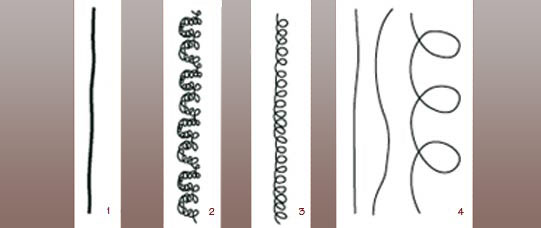
1° Asian, 2° African, 3° mixed race, 4° Caucasian (Western)
The characteristics of keratin are genetically transmitted. It can therefore be more or less thick or coloured, more or less resistant and flexible, depending on the genome of each individual, i.e. their family and ethnic heredity. Over the course of a lifetime, the keratin we are born with can weaken significantly. The most common cause of alteration is androgenetic factor, is also inherited. Bleaching, the point at which keratin produces only colourless hair because its melanin production has stopped, is also genetically determined.

